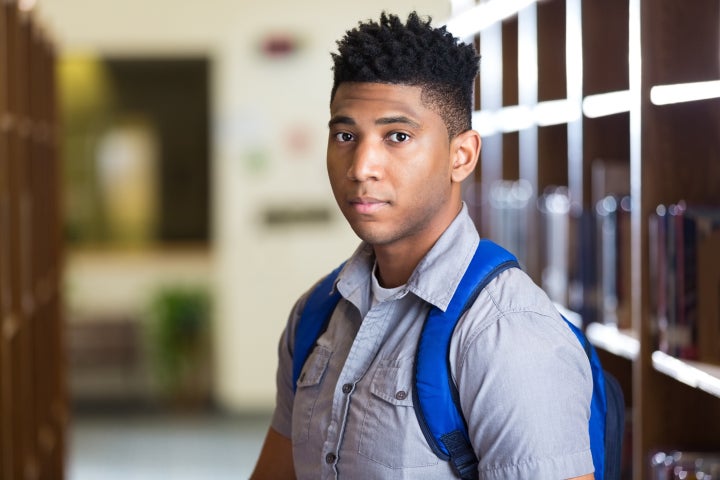
Institutional racism has historically been a pervasive problem in the United States. One that has prevailed even in our educational institutions, from public elementary schools, to elite private universities across the nation. As an immigrant Latina from a small rural town in Ecuador, where most of the elders still speak Quichua - the native language of the indigenous people of the country, learning to navigate a system that not only discriminates based on race but also on socioeconomic status, became crucial for my survival.
The U.S. Department of Education’s Civil Rights Data Collection 2013-14, a survey of all public schools and districts in the nation, revealed that students of color, as well as those whose first language is not English, are not getting the same educational opportunities as their classmates who are white or for whom English is their first language. This is because students of color get less access to experienced teachers and rigorous courses. Eleven percent of black students and 9% of Latino students attend schools where more than 20% of their educators are in their first year of teaching. Only 5% of white students face the same situation. Additionally, high schools with a high number of Latinos and Blacks are less likely to offer high-level math and science courses.
More strikingly, in New York City, according to the The State of New York’s Failing Schools 2015 Report, two-thirds of students from 3 to 8 grade are not proficient in Math and English. Moreover, a Research Alliance for New York City Schools report, found that in 2013, more than half of the students admitted to the specialized high schools came from only 4.5% of the city’s middle schools. Even more appalling, according to the Department of Education latest figures, although African Americans and Latinos make up 68% of eighth graders overall, only 11% of them got offered admission into one of New York’s specialized high schools this year.
One big problem is that New York Schools are the most segregated in the nation, as the 2014 UCLA Civil Rights Project revealed in their report: New York State’s Extreme School Segregation. More crucially, across the nation, property taxes and public school funding for elementary and secondary education are closely linked. When poor neighborhoods are primarily composed of people of color and immigrants, and their property values are not as high as in white dominated neighborhoods, the educational quality and resources available to people of color is significantly diminished. For Latinos and other students of color, this translates to lower admissions to selective high schools, lower high-school graduation rates and lower admissions into selective colleges.
While growing up in Corona Queens, an immigrant community primarily composed of Latinos and other minority groups, I experienced the impact of these statistics first hand. Schools in my area did not have enough funding to teach or tutor students the substantive material that would have helped them gain admission to competitive or specialized high schools where they could have had access to a quality education. Additionally, immigrants and other minority groups often lack the resources to pay for special tutoring or classes that would train their children to score well on the specialized high schools test known as SHSAT. Thus, it is no surprise that the number of African American and Latino students taking this test and gaining admission to these schools has decreased from last year. Additionally, in New York City, Latinos and African Americans graduate high school at a lower rate than white students. According to City figures, in 2015 for example, Latinos and African Americans graduated at a rate of 64% and 65.4% respectively. White students, on the other hand, graduated at a rate of 82%.
The race disparity becomes more prevalent in post secondary education. According to the Pew Research Center, even though more Latinos are getting a post secondary education than ever before, they still lag behind other groups in obtaining a four-year degree. In 2013, among Latinos ages 25-29, just 15% of them reported having a bachelor’s degree or higher. By comparison, among the same age group, 20% of Blacks and 40% of Whites reported having a bachelors degree or higher. Additionally, Latinos are less likely than other groups to: enroll in a four year college, enroll as a full time student, attend an academically selective college, and less likely to complete their bachelors degree.
The few of us that make it through the maze of our public educational institutions and seek to better our educational opportunities by attending one of the private universities are exposed to added pressures in the form of racial bias that our white counterparts do not have to endure. The sense of alienation and insecurity increases when you attend an institution that has a low number of diverse students. Racial bias suddenly hits you when you are answering a question in class and the teacher points out your accent. Or for example, when you are hanging out with your classmates on a Friday night, and they tell you that to avoid being called on in class you should “just pretend that you do not speak English.” Such experiences make you hyper-aware of your skin color and the way others perceive you, and not in a “I’m a proud Latina” type of way, but rather in an isolating, frustrating manner that clouds your concentration in class and affects your encounters with others. Reporting biased behavior and confronting it head-on can be empowering and can give one peace of mind.
Such experiences of discrimination are common among people of color. A 2012 UCLA study by the Higher Education Research Institute, revealed that underrepresented students experience more racial discrimination at low-diversity institutions. The 2015 Diverse Learning Environments Survey found that 57.5% of students witnessed discrimination on campus. Out of those, 40.6% reported having experienced discrimination, harassment or bias related to their race or ethnicity. The type of discrimination reported ranged from actions, verbal comments, exclusion and written harassment. Additionally, a survey by the Pew Research Center revealed that among Latinos ages 18 to 29, 65% of them reported having experienced racism or unfair treatment because of their race or ethnicity. This is no different than the African American community within the same age group.
Campus climate has been found to impact academic success for minority students. The Higher Education Research Institute also reported that experiences of discrimination negatively affect a sense of belonging and retention even among the highest achieving African American and Latino students. Having a diverse curriculum that teaches students about diversity and how to be welcoming towards different groups could help lessen discrimination among students. It is also important that minority students have access to a support group via active student groups that seek to increase and advocate for the interest of such students. Most importantly, the faculty and professors should create an inclusive environment that fosters learning and encourages everyone to voice their opinions while being respectful and accepting of the differences of others. Faculty should be given training in how to create a safe and inclusive environment for all types of students and on how to prevent alienating certain ethnic groups. More crucially, educational institutions should be responsive to student complaints, should hold the faculty accountable for biased behavior in the classroom and ensure that such behavior is discouraged.
In order to close the racial and economic gap in our education institutions we must start at the bottom and fix the broken framework that our system is based on. We must push for educational reforms that give Latinos and African American students from lower income neighborhoods a chance at receiving a quality education equal to that of their white counterparts living in wealthier neighborhoods. Our public education institutions should not be so closely tied to property taxes. Rather, all public institutions should be funded equally to ensure that each student has access to the same quality resources and education. Additionally, the government should further incentivize schools primarily composed of low-income minority students to offer low-cost tutoring or classes in order to prepare students for tests such as the SHSAT and the SAT. Such classes will ensure that students of color have a real chance to attend selective educational institutions. This would help increase diversity in private educational institutions across the nation and help lessen instances of racial bias and isolation that students are exposed to while attending these schools.
Our government should take affirmative steps to get rid of the segregated school systems in our nation and make sure all students, regardless of race, have the tools necessary to have a successful future.
Ana Guillcatanda is an activist for immigration reform and workers rights. She is currently a law student and Community Director with the Liberal Party of New York.
